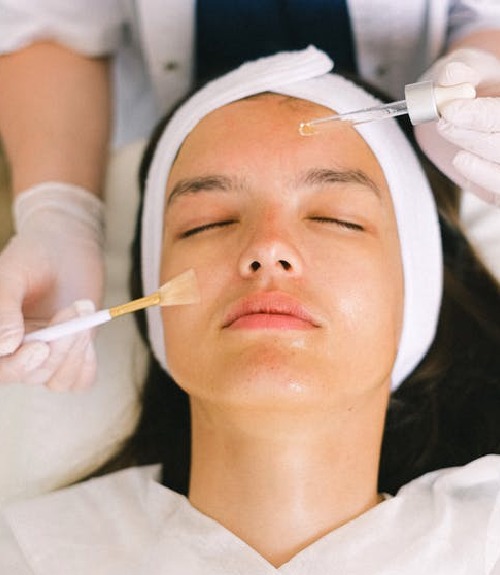With passing time, our skin might lose its charm because of many factors, including aging or exposure to environmental pollutants. A chemical peel can give your skin a new life in this scenario. Before trying this treatment, it is essential to know everything about chemical peel, including its types, safety, and risks.
First, let’s get to know what a chemical peel is actually.
What Is A Chemical Peel?

A chemical peel is a treatment in which a chemical solution is used to treat the skin’s texture, including scaring and other discolorations. The chemical used here is intended to strip off the top layer of our skin, revealing youthful skin underneath. A chemical peel is suitable for almost every skin condition.
It can reduce acne and improve fine lines, wrinkles, uneven skin tone, and scarring. The treatment can cause possible skin injury if not appropriately administered; for this purpose, it is not advised to get chemical peeling at home. It is always better to rely on professionals if you consider this treatment.
The procedure can last up to 30-90 minutes, and it can take about 14 days to heal completely; however, the redness may last for several months. After the treatment, you would notice redness, burning, or tingling. If you see some unusual swelling or sensations for a longer time, contact your physician ASAP!
Additionally, there can be several sessions for a chemical peel that would depend upon your skin’s texture. Usually, a lot of people can get some noticeable results from the first session. However, other times you can also be advised to get additional sessions.
Types of Chemical Peels
Before you jump-start your treatment, you must understand the different chemical peel types. Some of the most common chemical peels are; Superficial peels, medium peels, and deep peels. Chemicals used in each type are different, and their effects can vary widely.
The superficial peel remains the most commonly used chemical peel and is commonly suggested by dermatologists. It uses acids like alpha-hydroxy acid, which works as a gentle exfoliator to eliminate the outer skin layer. Additionally, superficial peels are known to penetrate the skin’s outermost layer only.
Medium peels are used to get visible and drastic results. It uses trichloroacetic or glycolic acid and acts on the outer and middle layers of the skin. Medium peels are most effective for those people who want to get rid of the damaged skin cells instantly.
If superficial and medium peels aren’t doing the work for you, you might have to go for the deep peels. As the name suggests, it deeply penetrates the skin’s middle layer and acts on the skin cells that are completely damaged. Common chemicals used here are trichloroacetic acid or phenol.
Is A Chemical Peel Good For All Skin Types?
Not every chemical peel is good for all skin types as it can expose your skin to some possible complications. Superficial peels like AHA and BHA are suitable for every skin type. However, trained professionals can help you determine what kind of chemical peel best suits your skin and desired outcomes.
If you have been through skin treatment like Isotretinoin during the past six months, inform your doctor beforehand of the procedure. People with dark skin tones must not go for deep peels as it can cause skin conditions like dyschromia, and the chances of scarring are high here compared to other skin tones.
If you have any skin allergies or other skin-related issues, do not forget to mention them before getting the treatment. To remain safer, starting with a light chemical peel is advised. A wise decision here is to seek help from certified dermatologists to avoid going through any adverse consequences.
Safety and Risks of Chemical Peels

With mild to medium chemical peels, you can expect some side effects like redness, irritation, and peeling. Such symptoms are known to last a few days and would get fine after a week. There are no such adverse reactions caused by chemical peeling. However, in rare cases, it can include scarring and even numbness.
Many of you might consider chemical peeling a risky procedure involving using chemicals. This treatment is a safe procedure only if performed by a certified dermatologist or aesthetician. If not properly done, you could have adverse consequences that can give you uneven skin tone.
After your first chemical peel, make sure not to use warm or hot water to wash your face. Wash your face with cold water to help you soothe the post-treated skin. Moreover, try to keep your skin moisturized, hydrated and sweat-free. Lastly, don’t forget to apply SPF on your face before stepping out in the sun!
Get That Baby Skin Now!
Chemical peeling is the most sensitive procedure because it directly uses chemicals on the skin’s top layer. If not done correctly, your skin can have some adverse consequences. Often incompetent or unauthorized doctors can make you go through many complications.
With us, you never have to worry about anything! The certified board of dermatologists and doctors with us know how to give your skin a new life while taking care of it. Book your slot with us now!
Bottom Line
Chemical peeling can provide a mild exfoliation effect to the top-most layer of your skin. This will eventually rejuvenate your skin and enhance your facial features without causing any harm. There are many chemical peels available, make sure to choose the right one according to your skin’s condition for better results.

Leave A Comment